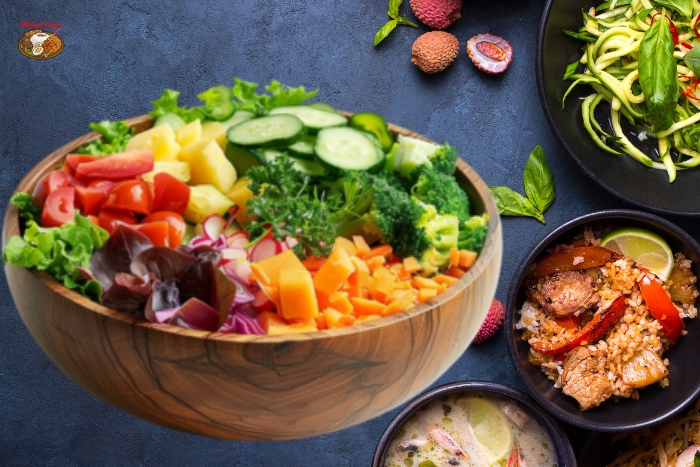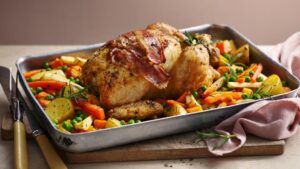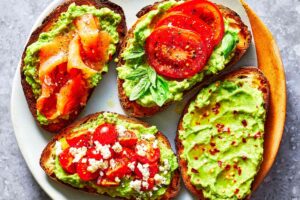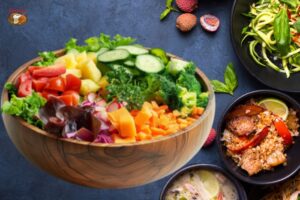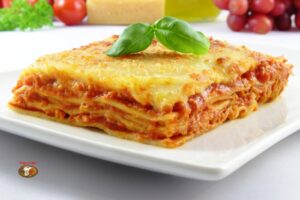A Vegan Buddha Bowl is a colorful plate filled with various fresh and wholesome ingredients, making it both nutritious and visually appealing. These bowls typically consist of a grain base, an assortment of vegetables, plant-based protein, and a delicious dressing.
History
Buddha bowls are believed to have originated from the idea of monks carrying bowls with food collected from alms. The name reflects the idea of balance and nourishment.
Nutritional Benefits
Vegan Buddha Bowls are packed with essential nutrients. They offer a good balance of carbohydrates, protein, healthy fats, vitamins, and minerals due to their diverse ingredients.
Basic Components
- Grain Base: Choose from quinoa, brown rice, or farro.
- Vegetables: Fresh or roasted options like spinach, bell peppers, carrots, or sweet potatoes.
- Protein: Use chickpeas, tofu, tempeh, or edamame for added protein.
- Healthy Fats: Avocado or nuts/seeds like almonds or sunflower seeds.
- Dressing: Make a simple tahini, lemon-tahini, or avocado dressing for flavor.

Vegan Buddha Bowl Recipe
Ingredients
- 1 cup cooked quinoa
- 1 cup spinach
- 1 small sweet potato roasted
- 1/2 cup chickpeas cooked
- 1/2 avocado sliced
- 2 tablespoons tahini
- 1 Juice of 1 lemon
- Salt and pepper to taste
Instructions
- Start by preparing the quinoa as per package instructions.
- Roast the sweet potato by cutting it into cubes, tossing in olive oil, salt, and pepper, and baking at 400°F (200°C) for 25-30 minutes.
- In a bowl, mix tahini with lemon juice, salt, and water to thin it out if necessary.
- Assemble the bowl: place quinoa at the bottom, add spinach, roasted sweet potato, chickpeas, and avocado on top.
- Drizzle with tahini dressing and enjoy!
The Vegan Buddha Bowl is one of the most popular plant-based meals around. It’s a well-balanced, colourful dish filled with grains, vegetables, protein, healthy fats, and a delicious dressing. Whether you’re a vegan or just someone who loves a healthy, nutritious meal, this recipe is for you.
In this article, we’ll walk you through everything you need to know about making the perfect Vegan Buddha Bowl, including its components, step-by-step instructions, and tips on how to make your own variations.
What is a Vegan Buddha Bowl?
A Vegan Buddha Bowl is a bowl filled with a variety of ingredients that together form a healthy, balanced meal. The concept of the Buddha Bowl comes from the idea of balance, with the ingredients complementing each other in both flavour and nutrition. It typically contains:
- A base like grains or starches
- Protein such as beans, tofu, tempeh, or lentils
- Vegetables, either raw or cooked, to provide vitamins and minerals
- Healthy fats like avocado, seeds, or nuts
- A dressing to bring the whole bowl together with added flavour
A Buddha Bowl is not just nutritious, it’s also highly customisable. You can adjust the ingredients based on your preferences or what you have available in your kitchen.
Benefits of a Vegan Buddha Bowl
Before diving into the recipe, let’s take a look at why Vegan Buddha Bowls are so popular.
- Nutrient-Dense: Buddha Bowls are packed with nutrients, including fibre, protein, vitamins, and minerals. This makes them a great option for people who want to eat healthy, plant-based meals.
- Customisable: You can change the ingredients based on what you have in your kitchen. Whether you’re looking to add more greens or switch up the grains, you can create a Buddha Bowl that suits your taste.
- Quick and Easy: Buddha Bowls are easy to make and don’t require complicated cooking techniques. Most of the time, you’ll just need to prepare a few simple ingredients and toss them together.
- Perfect for Meal Prep: Since Buddha Bowls store well in the fridge, they’re great for meal prepping. You can prepare your ingredients in advance and assemble them whenever you’re ready to eat.
- Delicious and Filling: A Buddha Bowl is a hearty meal that will keep you satisfied. With the right combination of protein, healthy fats, and fibre, it’s a well-rounded dish.
Ingredients for a Vegan Buddha Bowl
To make your Vegan Buddha Bowl, you’ll need to gather a few key ingredients. We’ve divided them into categories to help you easily assemble the perfect bowl.
1. The Base (Grains and Starches)
The base is the foundation of your Buddha Bowl. It’s typically a whole grain or starch that provides complex carbohydrates and helps keep you full. Here are some options for your base:
- Quinoa: A gluten-free, protein-packed grain that’s light and fluffy. It cooks quickly and adds a nutty flavour to your bowl.
- Brown Rice: A whole grain that’s full of fibre and has a nutty, chewy texture. Brown rice is a classic option and works well with almost any combination of ingredients.
- Sweet Potatoes: Roasted sweet potatoes are naturally sweet and add a creamy texture to your bowl. They are high in vitamins and antioxidants.
- Farro: An ancient grain that’s nutty and chewy. Farro adds an earthy flavour and is a great alternative to rice or quinoa.
- Couscous: A light, fluffy grain that’s easy to prepare. Couscous pairs well with fresh vegetables and creamy dressings.
- Barley: This grain has a slightly chewy texture and is rich in fibre. Barley works well as a base for a Buddha Bowl and absorbs dressings well.
2. Protein Sources
Protein is an essential part of any meal. In a Vegan Buddha Bowl, you can add a variety of plant-based proteins to keep your meal filling and nutritious.
- Chickpeas: These small legumes are packed with protein and fibre. You can roast them in the oven for a crispy texture or leave them soft for a creamier bite.
- Tofu: Tofu is made from soybeans and is a great source of plant-based protein. You can pan-fry, bake, or grill it to add texture and flavour.
- Tempeh: Tempeh is made from fermented soybeans. It has a firmer texture than tofu and a nutty flavour. It’s perfect for grilling or sautéing.
- Lentils: Lentils are an excellent source of plant protein. They cook quickly and can be added to your Buddha Bowl as a warm, hearty protein source.
- Edamame: Edamame are young soybeans and are rich in protein and fibre. They’re perfect for adding to your bowl for a quick protein boost.
3. Vegetables
A Buddha Bowl wouldn’t be complete without a variety of vegetables. Vegetables are full of vitamins, minerals, and antioxidants, which are essential for overall health.
- Kale or Spinach: These leafy greens are rich in iron and fibre. Kale can be massaged with a little olive oil to make it softer and easier to eat.
- Carrots: Carrots are naturally sweet and crunchy. You can slice them thinly or roast them for a caramelized flavour.
- Cucumbers: Fresh cucumbers add a crisp texture and refreshing flavour to your bowl. They’re low in calories and hydrating.
- Beets: Roasted or pickled beets are rich in vitamins and add vibrant colour to your bowl. They have a sweet, earthy flavour.
- Peppers: Bell peppers are packed with vitamin C and add crunch and sweetness to your bowl.
- Avocado: Avocado adds healthy fats and a creamy texture to your Buddha Bowl. It also helps make the dish more satisfying.
- Tomatoes: Fresh tomatoes provide juiciness and a tangy flavour. Cherry tomatoes or grape tomatoes are easy to add to your bowl.
4. Healthy Fats
Healthy fats are an important part of any meal. They help keep you full and provide essential nutrients. Here are some sources of healthy fats to include in your Buddha Bowl:
- Avocado: A creamy fruit full of healthy fats. Avocado is rich in monounsaturated fats, which are good for heart health.
- Nuts and Seeds: Almonds, sunflower seeds, chia seeds, and pumpkin seeds are great options for adding healthy fats and crunch to your bowl.
- Olives: Olives are rich in healthy fats and bring a briny, salty flavour to your Buddha Bowl.
- Tahini: Tahini is made from sesame seeds and is full of healthy fats. It’s often used in dressings or drizzled over the top of a Buddha Bowl.
5. Dressing
A great dressing can tie all the flavours together. Here are some simple and tasty vegan dressing options:
- Tahini Dressing: Mix tahini, lemon juice, garlic, maple syrup, and water to create a creamy and tangy dressing.
- Lemon-Tahini Dressing: A lighter version of tahini dressing with lemon juice for added freshness.
- Peanut Sauce: Combine peanut butter, soy sauce, lime juice, and ginger for a creamy, slightly spicy sauce.
- Balsamic Vinaigrette: A simple dressing made with balsamic vinegar, olive oil, mustard, and maple syrup for a sweet-tangy finish.
- Avocado Lime Dressing: Blend avocado with lime juice, garlic, and olive oil for a creamy, zesty dressing.
How to Make the Perfect Vegan Buddha Bowl
Now that you’ve gathered your ingredients, let’s go through the steps to make a perfect Vegan Buddha Bowl.
Step 1: Prepare the Base
First, you’ll need to cook your base. If you’re using grains like quinoa or brown rice, follow the instructions on the package. For example:
- For Quinoa: Rinse 1 cup of quinoa under cold water and cook it with 2 cups of water. Bring it to a boil, then cover and simmer for 15 minutes until the water is absorbed and the quinoa is fluffy.
- For Brown Rice: Combine 1 cup of brown rice with 2 cups of water. Bring it to a boil, then cover and cook on low heat for 30-40 minutes.
- For Sweet Potatoes: Peel and cube the sweet potatoes. Toss them with olive oil, salt, and pepper, and roast them at 200°C (400°F) for 25-30 minutes, turning halfway through.
Step 2: Prepare the Protein
Next, cook your protein. Depending on what you choose, follow these simple instructions:
- For Chickpeas: Drain and rinse one can of chickpeas. Toss them with olive oil and seasoning, then roast them at 200°C (400°F) for 20-25 minutes until crispy.
- For Tofu: Press the tofu to remove excess water, then cut it into cubes. Sauté in a pan with olive oil until golden and crispy.
- For Tempeh: Slice the tempeh and sauté it in a pan with a bit of oil until it’s crispy and golden.
Step 3: Prepare the Vegetables
Wash and prepare your vegetables. Here are some tips:
- For Kale: Wash the kale, remove the stems, and chop it into small pieces. Massage the kale with olive oil to make it tender.
- For Carrots: Peel and chop the carrots into thin rounds or matchsticks.
- For Cucumbers: Slice the cucumbers into thin rounds.
- For Avocado: Cut the avocado in half, remove the pit, and slice it just before serving.
Step 4: Make the Dressing
Whisk together your chosen dressing ingredients in a small bowl. Adjust the seasoning to taste. If the dressing is too thick, you can add a little more water to thin it out.
Step 5: Assemble the Buddha Bowl
Once everything is ready, it’s time to assemble your Buddha Bowl. Start by placing the base at the bottom of the bowl, followed by the protein, vegetables, and healthy fats. Drizzle your dressing over the top, and garnish with seeds, nuts, or herbs if desired.
Variations of the Vegan Buddha Bowl
Here are a few variations to try if you want to switch things up:
- Mexican-Inspired Buddha Bowl: Use brown rice as the base and top with black beans, corn, avocado, salsa, and a cilantro-lime dressing.
- Asian-Inspired Buddha Bowl: Use quinoa as the base and add edamame, carrots, cucumber, avocado, and a peanut sauce dressing.
- Mediterranean-Inspired Buddha Bowl: Use couscous as the base and add chickpeas, olives, cucumber, tomato, and a lemon-tahini dressing.
- Autumn-Inspired Buddha Bowl: Use roasted sweet potatoes as the base and top with cranberries, pecans, kale, and a balsamic vinaigrette.
Conclusion
The Vegan Buddha Bowl is a perfect meal for anyone looking to eat more plant-based food. It’s easy to make, packed with nutrients, and can be customised to your tastes. By following this guide, you’ll be able to create a delicious, filling, and balanced Buddha Bowl that’s perfect for lunch, dinner, or meal prep.
Enjoy your healthy and colourful Buddha Bowl today!

